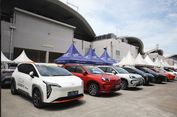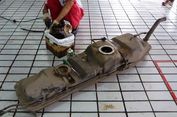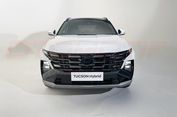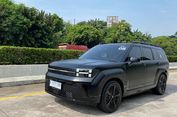Nissan Dualis+2
KOMPAS.com -. The number of crossover vehicles on the road these days is enough to send a buyer, well, cross-eyed.
The Nissan Dualis+2 is the latest of this hard-to-pigeonhole breed. It seats seven but it's no bigger than some small cars and it looks like a four-wheel-drive, even though most versions drive just the front wheels.
The +2 is a stretched version of the standard Dualis. It's about 20 centimetres longer and the distance between the front and rear wheels (the wheelbase) has been extended to free up room for two third-row seats. In the process, the full-size spare has also been sacrificed for a space-saver.
It won't compete with genuine people-movers for space and load-carrying ability but that's not the goal. The +2 is aimed at drivers who prefer a small hatch in town but occasionally need a couple of extra seats for the kids' friends.
Price and equipment
The extra seats and load area come at a $2500 premium over the corresponding Dualis. The +2 comes in three models: two front-drive versions, the ST and slightly more luxurious Ti, and an all-wheel-drive Ti model.
The ST gets 16-inch alloys, cloth trim, a single-CD player with Bluetooth and an MP3 player jack, cruise control, a big, chilled glovebox, roof rails and a rear cargo blind.
The front-drive Ti we tested costs another $4700 ($34,690) but includes leather trim, a super-sized sunroof, climate control airconditioning, heated seats, a six-stack CD player, 18-inch wheels, tinted rear windows, auto headlights, fog lights, rain-sensing wipers and a smart key that unlocks without leaving your pocket.
The +2 doesn't skimp on safety gear, with six airbags, stability control and seven adjustable headrests as standard equipment and a five-star crash rating. The only notable omission is a rear camera/parking sensors.
Under the bonnet
The +2 gets the same 102kW four-cylinder engine as the standard Dualis, matched to a continuously variable transmission.
The engine is only just adequate in the five-seat Dualis and struggles to shift the extra weight of the bigger +2, especially when most of the seats are in use. The engines in small cars such as the Mazda3 and Toyota Corolla have similar power outputs but are shifting roughly 200 kilograms less.
The result is lethargic performance off the line, which can make it tiresome to drive in town. Once the car is moving, the engine is effective enough, although hills and overtaking call for some forward planning.
The engine is quiet, once you get used to the fact that the CVT doesn't change gears; the revs simply ebb and flow with the force on the accelerator. The transmission also surges when you adjust the cruise control.
The +2 is slightly thirstier than the regular Dualis, using a claimed 8.5 litres per 100 kilometres, compared with 8.2L/100km. We achieved about 10 litres per 100 kilometres in a mix of city and freeway driving.
How it drives
The original Dualis did not iron out the bumps as well as some competitors, prompting Nissan to revise the suspension. Mostly, the tweaks have succeeded and the Dualis is a comfortable ride in city and country. It can jar over bigger potholes and road joins, though.
The softening of the suspension hasn't had too much impact on the Dualis's road-holding. It still sits commendably flat through corners, with less body roll than you'd expect from a seven-seater. Vague steering means it's not up with the class-leading small hatches for driver enjoyment but it's predictable and composed. Comfort and practicality
When you get into the Dualis+2 you feel perched on the seat because of the high-riding position and lack of under-thigh support. The rear seats are also a bit flat.
The rest of the cabin layout is impressive. The instrument panel is clean and clear, with a digital readout between the speedo and tacho that gives average speed, fuel consumption, range, chosen cruise control speed and distance to empty. The refrigerated glovebox is bigger than most, while there's plenty of storage in the front and rear doors and on the front seat-backs.
Access to the third-row seats is relatively fuss-free because the middle row of seats slides forward to leave a decent gap. The sliding second row also means you can mix-and-match the legroom for your five rear passengers. Little ones in the back? Free up space for teens in the middle seats. Baby seat in the middle pews? Give the rear passengers more legroom.
The rear seats are really only for smaller children. Taller teenagers won't have enough headroom and will sit with their knees up.
Ventilation could also be a problem; there are no vents for the second and third rows. Space behind the third-row seats is limited, although comparable with other smaller seven-seat SUVs. The third row also split-folds, while the second row has a 40/20/40 configuration, which gives plenty of flexibility for a mixed load of people and luggage.
The middle seat of the second row folds down and has two cupholders, some storage and a 12-volt power outlet - a nice touch.
Simak breaking news dan berita pilihan kami langsung di ponselmu. Pilih saluran andalanmu akses berita Kompas.com WhatsApp Channel : https://www.whatsapp.com/channel/0029VaFPbedBPzjZrk13HO3D. Pastikan kamu sudah install aplikasi WhatsApp ya.



































